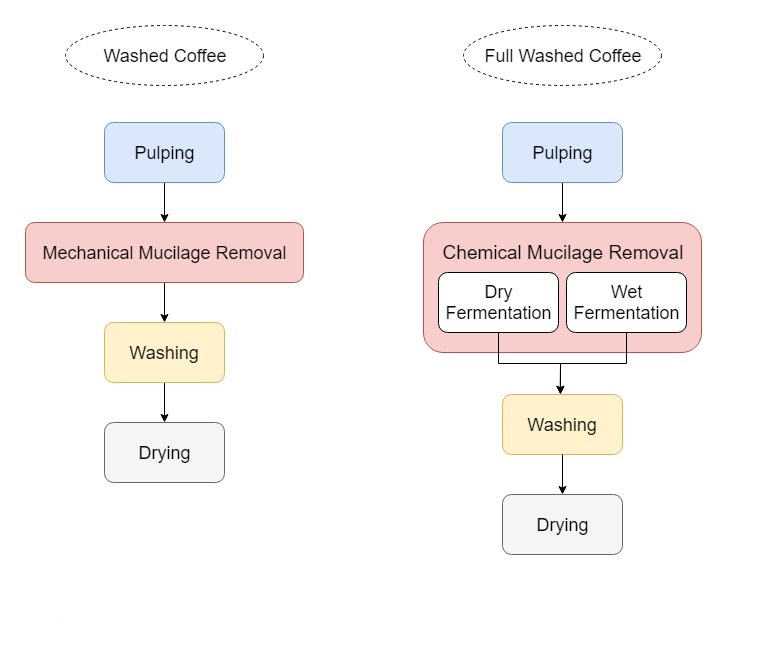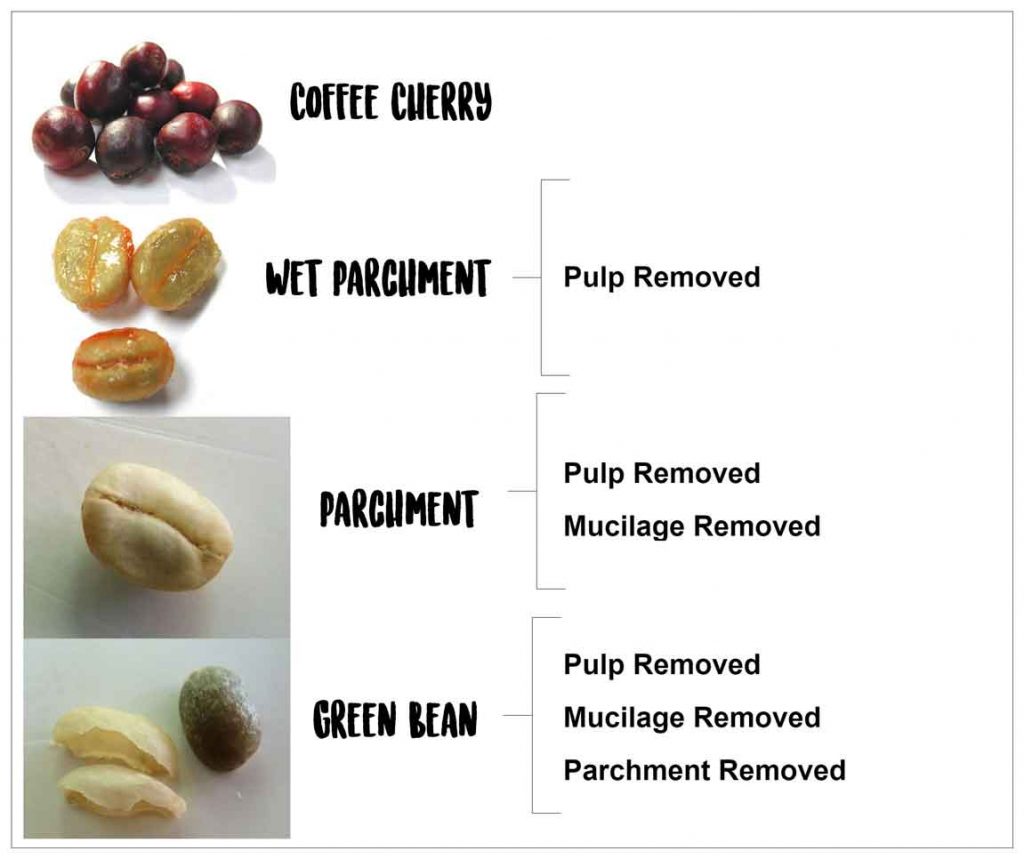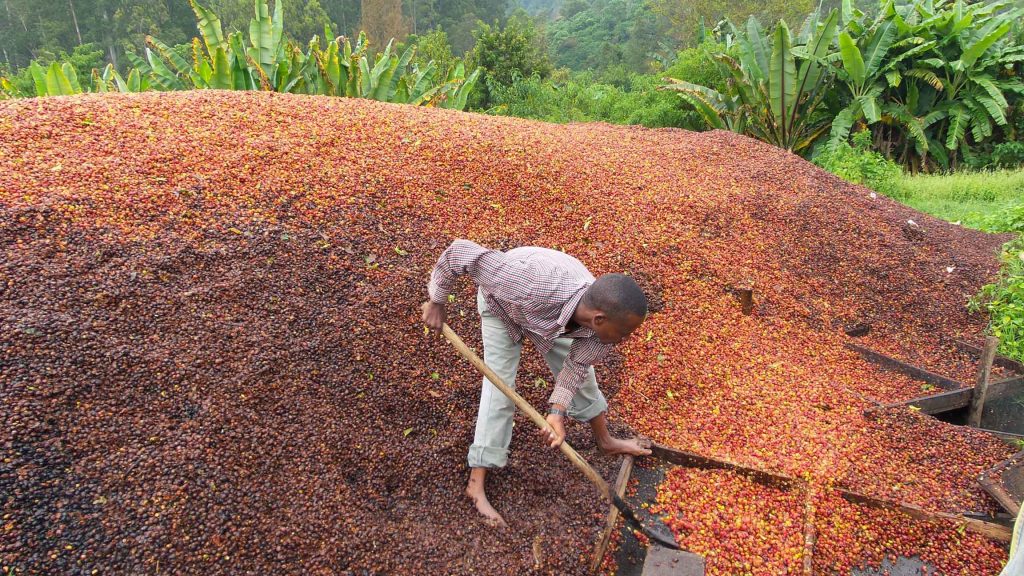What is washed coffee?
“Washed coffee refers to a processing method where coffee fruits are mechanically de-pulped and mucilage is washed off biochemically or by friction prior to the drying stage.”
Coffee is technically a drupe or a stone fruit; fruits characterized by a hard shell in the center surrounded by a fleshy outer layer; some examples include cherries, dates, peaches, apricots, plums, avocados, mangoes, etc. However coffee is one of those few instances where we favor consuming the fruit’s seeds rather than the flesh and pulp around them; among those exceptions we could mention walnuts, almonds, pistachios, coconuts, guarana and cocoa.
To remove the unwanted pulp and expose the precious beans; coffee processors have developed a technique intended to systematically remove and discard the entire outer layer and mucilage from the fruit. The coffee processed using this method is popularly known as washed coffee.

Washed coffee is generally divided in two types: washed and fully washed coffees; both processing methods are similar and both begin by the pulping stage, where coffee cherry’s outer skin is mechanically removed from the fruit.
The resulting seeds are slippery and covered with a gooey substance. Farmers identify this stage as “Wet Parchment”; the substance coating the seeds is mucilage, and it must be removed before coffee could be ready for the next stage. The “Drying Stage”.
SEE ALSO: Could coffee be a sustainable crop?
The process used to remove the mucilage, widely differs between the washed and fully washed coffees. The fully washed method uses a bio-chemical reaction where sugars are fermented by microorganisms and enzymes until the mucilage is loose and dissolves easily into water, either by piling up the “Wet Parchment” into tanks or by dipping it into water for several hours or even days until the mucilage finally comes off (dry and wet fermentation respectively). The washed method however uses a mechanical device called “Demucilager” that removes the mucilage by friction and pressure water; saving time and space by leaving the seeds completely clean and ready almost immediately for the “Drying Stage”.
Both methods could be used interchangeably by farmers depending on time, capacity or flavor/quality modulation.

The Good
- By discarding fruit’s pulp and flesh, washed coffee processing eliminates most of the coffee’s moisture; dropping it between 60 to 70% and volume by up to 50%. Cutting down as much as in half the drying time and space.
- Along with the pulp and flesh, most of the sugars contained in the fruits are also discarded. Minimizing the risk of adverse fermentation and the development of off flavors that could damage the beans or inversely affect their consistency during later coffee processing stages, storage or transportation.
- Fully washed coffees allow farmers, by using controlled fermentation methods, adding new dimensions, deepness, mouthfeel and complexity to coffee’s sensory’s profile. Increasing coffee’s subsequent price, market niche and overall value into global markets
- Washed coffee only represents 20% of the coffee market and generalized popular belief of higher value and quality. Its scarcity and general consistency keep prices higher than any other coffee processing method.
The Bad
- Washed and fully washed coffee process requires infrastructure, technology and energy most coffee farmers around the world can hardly afford. Nearly 80% of them live below the poverty line, with less than $2/day.
- The production of washed and fully washed coffees carries out a huge environmental responsibility along with it. All waste water resulting out of the process, should be efficiently retained until pH is neutralized and all organic matter trapped or reduced. Only then, water could be returned back to the environment or used for irrigation.
- Besides waste water, washing stations generate tons of solid waste; 60% of each coffee cherry is misuse. Technically, after being composted, coffee pulped could be an excellent organic fertilizer; an exceptional source of nutrients and micronutrients for coffee trees. Therefore, all washing stations should have a compost factory, complemented by a meticulous plan to produce and distribute fertilizer back to coffee farmers and plantations.
SEE ALSO: How can we help smallholder coffee farmers?
The Ugly
- Washed coffee’s higher market tag prices equally attract the opportunist, untrained, unethical and underprivileged entrepreneur alike, who tend to develop unsuitable washing station facilities; damaging not only the environment and water resources around them but also generating water insecurity among the most vulnerable rural populations in the world.
- Environmental regulations are not equally enforced, or do not exist at most coffee producing nations. What makes washed and fully washed coffees, a potential thread for the environment and water resources. Misuse of water and water pollution should always be, despite the circumstances, unacceptable.
- Dealing with solid waste is expensive, most washing stations do not have the right incentives to compost and transport organic fertilizers back to farmlands where it is widely needed. Once coffee arrives to washing stations, it changes ownership. Therefore, coffee farmers don’t receive the benefits of organic fertilizers made out of coffee by-products. All coffee waste and coffee pulp end up far from farmlands, inside pits and huge useless piles, damaging and polluting the whole area around them.

What can you do?
- Prefer always sundried natural coffees over washed ones.
- The coffee industry is characterized for questionable and unethical sourcing, get involved and always ask questions about your coffee, bring environmental and social issues up. Don’t settle and always demand information about the producer and his circumstances.
- Learn more about coffee and how the choices you made could have a potential impact in the industry.
